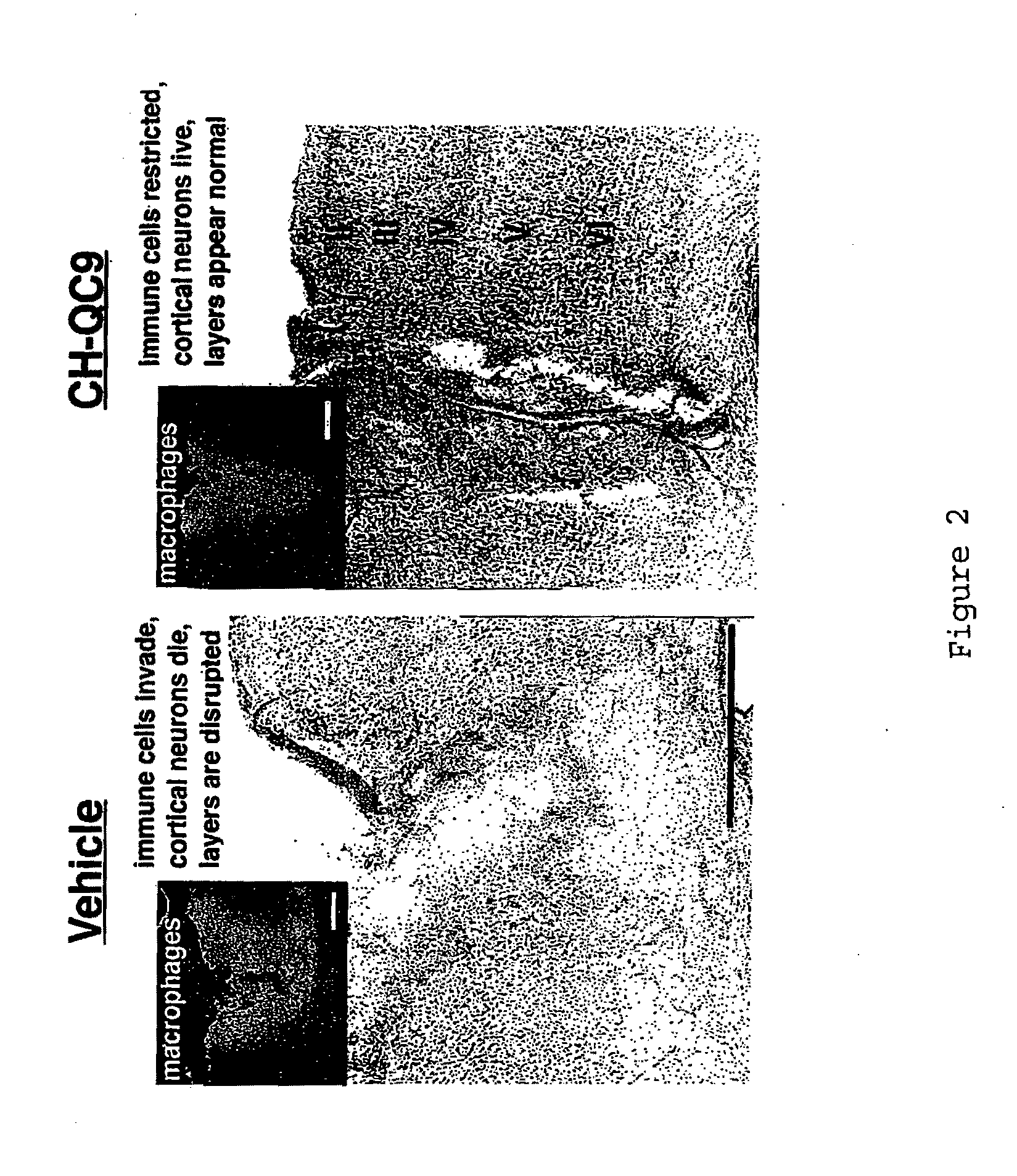Small Survival-Promoting/Immunomodulatory Peptide for Treatment of Brain Damage, Neurodegenerative Disorders, and Inflammatory Disorders
a survival-promoting and immunomodulatory peptide technology, applied in the direction of peptide/protein ingredients, animal/human proteins, drug compositions, etc., can solve the problems of difficult to determine which neurotrophic factors are effective on a particular neuronal population, and difficult to determine the specificity of endogenous neurotrophic agents. to achieve the effect of convenient administration or testing of chec-9 peptides
- Summary
- Abstract
- Description
- Claims
- Application Information
AI Technical Summary
Benefits of technology
Problems solved by technology
Method used
Image
Examples
example i
Survival of Neural Cells is Supported by CHEC-9
[0072]A thirty amino acid N-terminal fragment of DSEP called Y-P30, was originally purified from the culture medium of neural cell lines exposed to hydrogen peroxide. Y-P30 promotes neuron survival and inhibits the appearance and differentiation of monocytes derivatives (macrophages / microglia) in vitro and in vivo, including after systemic administration (Cunningham, T J et al., 1998; Cunningham, T. J., et al., 2000). The cDNA and the gene location for full length human DSEP have been identified and encode a 12 kD secreted polypeptide. When the full-length human protein is expressed in either mouse or human neural cells, these cells become resistant to a variety of toxic treatments, including immune cell attack in xenocultures and in vivo (Cunningham T J, et al., in press).
[0073]Based on the Y-P30 experiments, it was concluded that the survival and immune evasion activities of DSEP could be accomplished for the most part by the N termin...
example ii
CHEC-9 is a Potent Phospholipase A2 Inhibitor, and Also Inhibits Paltelet Aggregation
Measurement of PLA2, Platelet Activity
[0080]Trunk blood was collected from 16 additional Long Evans and Sprague Dawley rats of both sexes following decapitation. Fourteen of these rats were paired according to strain, sex, and weight and injected with a control peptide / vehicle or with CHEC-9 forty-five minutes prior to sacrifice. Phospholipase A2 activity was determined in 10 rats and platelets were isolated from the remaining 6 animals.
[0081]Serum samples and purified bee venom phospholipase were tested for PLA2 activity using a 1,2-bis(heptanoylthio) glycerophosphocholine substrate (Caymen Chemical) which produces a DTNB reactive sulfhydryl upon cleavage of phospholipids at the at the sn-2 position (target of all PLA2 enzymes). DTNB reactivity with serum, peptides, or PLA2 at the concentrations used in these experiments was not detectable in the absence of substrate (or vice versa). This substrate...
example iii
Anti-Y-P30 Antibody Produces Increase in Cortical Lesion Size and Sera Toxicity
[0087]This example demonstrates that there is a DSEP-like polypeptide in the rat brain that cross-reacts with affinity-purified polyclonal anti-human DSEP antibodies (FIG. 6). Rats were immunized with the N terminal peptide of human DSEP (Y-P30) conjugated to Keyhole Limpet Hemocyanin (KLH). Reactivity of their sera to DSEP was confirmed by Western blots and ELISA. Small cortical lesions were produced in the immunized rats. When the rats were sacrificed the extent of damage from the lesion, and the response of macrophages / microglia was tested. Additionally, rat antiserum was tested in a cell viability assay. It was found that DSEP immunized rats have exaggerated cortical lesions and increased cytotoxicity of their sera.
Immunizations, Surgery, Adverse Reactions
[0088]Injections and boosts were subcutaneous, bilaterally in the shoulder over a period of 1.5 months. Control rats were immunized against KLH only...
PUM
| Property | Measurement | Unit |
|---|---|---|
| time | aaaaa | aaaaa |
| time | aaaaa | aaaaa |
| time | aaaaa | aaaaa |
Abstract
Description
Claims
Application Information
 Login to View More
Login to View More - R&D
- Intellectual Property
- Life Sciences
- Materials
- Tech Scout
- Unparalleled Data Quality
- Higher Quality Content
- 60% Fewer Hallucinations
Browse by: Latest US Patents, China's latest patents, Technical Efficacy Thesaurus, Application Domain, Technology Topic, Popular Technical Reports.
© 2025 PatSnap. All rights reserved.Legal|Privacy policy|Modern Slavery Act Transparency Statement|Sitemap|About US| Contact US: help@patsnap.com



